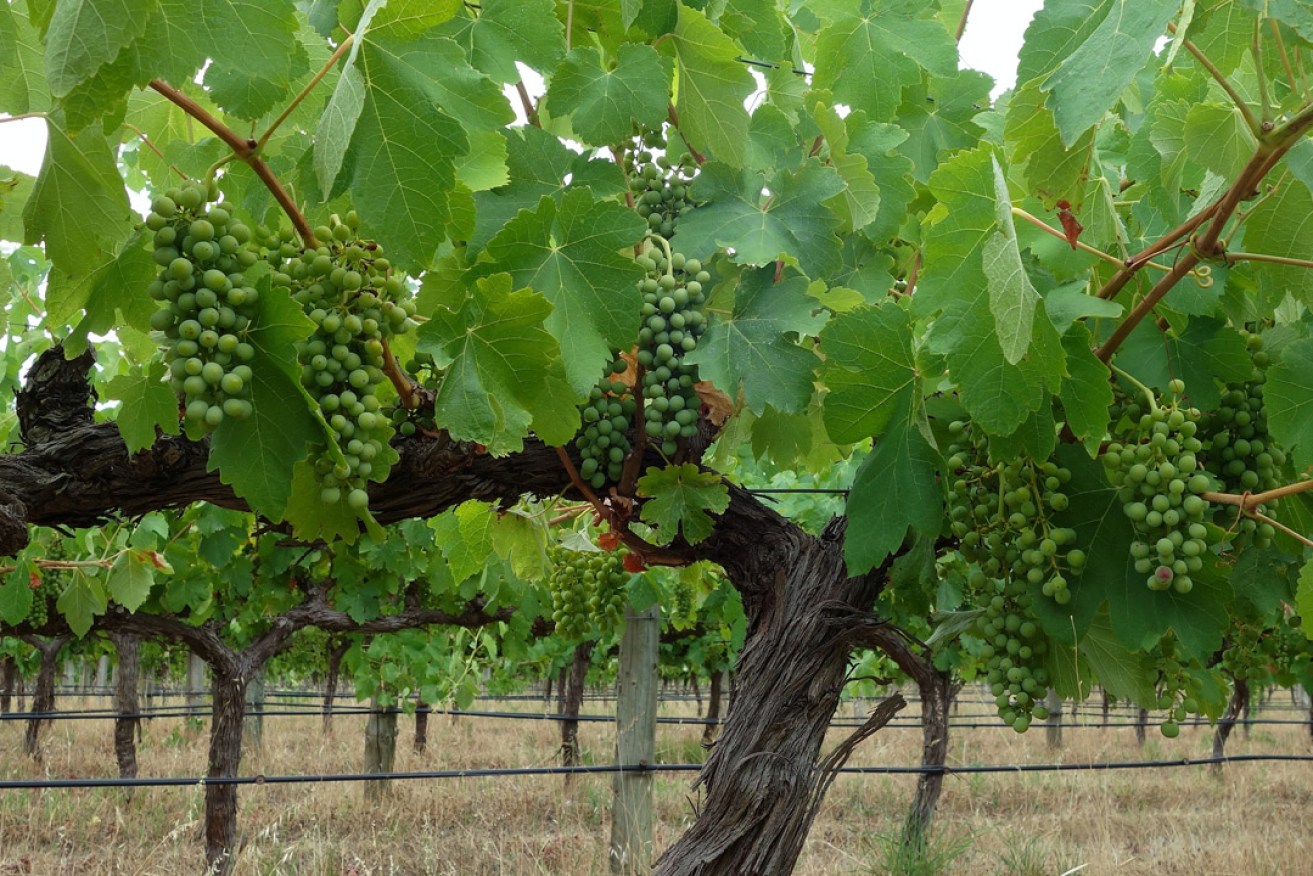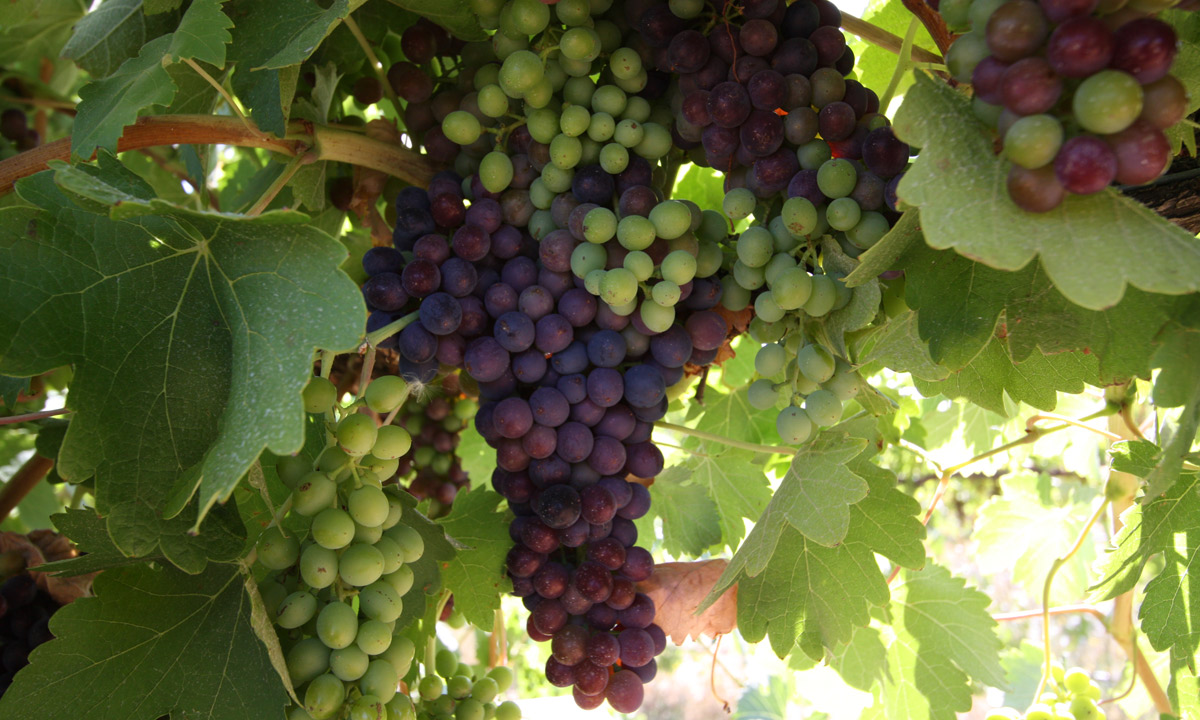SA heatwave jangles vigneron nerves
Welcome back. While you were away drinking – I trust it was good – something very interesting occurred. 2016 nearly happened in 2015.


Ironheart Vineyard Shiraz nearing veraison in McLaren Vale.
At Vinexpo, the essential winebiz show in Bordeaux, in about 1992, I witnessed Hunter Valley winemaker Philip Shaw talking with the Austrian stickymeister Willie Opitz. They spoke of one vintage in which Opitz picked his alpine botrytis wine the year after its vintage date and Shaw had picked a lot of his conventional Upper Hunter fruit the year before.
Between them, north and south, they came close to having a 12-month period without a harvest: while the Austrian vintage was very late, the Hunter was very early. Both eventually marketed their wine labelled with the year in which they would have preferred to pick: the year in which neither of them picked much at all.
In Australia, the 2016 vintage has come very close to starting in 2015. For some in the warmest regions, it probably did. They’ll stay schtum.
While harvest has well and truly commenced in some parts of the irrigated Murray-Darling Basin, the usual vintage rains in the sub-tropical Hunter have slowed its ripening and picking.
In the major profit-making regions of Barossa and McLaren Vale, the record-breaking pre-Christmas heatwave came close to making 2016 the earliest vintage yet. What prevented that, or has prevented it so far, was the tendency for vines to close down their metabolism in extreme heat.
They put their energy into the survival of the entire plant, not merely ripening their fruit. They’ll eventually drop leaves to reduce their evaporative surface area rather than make grapes.
The merciful post-Christmas cool, with the odd sprinkle of rain, has seen many of these early vineyards get back on with pumping their energy into ripening the grapes, and veraison is happening.
This is where the grapes begin to soften and change colour.
Vines have evolved to survive. Before humans began helping with this by planting cuttings, the only way the plant could procreate was through its seeds.
Before the seed has developed sufficiently to germinate, its protective sac – the berry – maintains a tough bitter skin and a pulp so packed with acid it works as a deterrent to predators. But once that seed is ready to shoot, the grape turns off its acid production, begins to make sugar, and changes from an unsavoury green to a more alluring colour, principally to attract hungry predators like birds, foxes and humans.
Critter devours grape; seed sprouts in warm belly ready to take root once it’s ejected in a scat of handy fertiliser; species survives. Clever.
What the vine didn’t foresee was the human addiction to alcohol. Our love of wine sees us planting vines all over the world by using cuttings, not seeds. Inadvertently, the vine has watched us apply our secondary industry to its primary effort and plant it much more widely than ever it could have spread if totally reliant on the sprouting of its seeds in incubating gizzards.
But while seeds have largely become redundant to the vine, please don’t tell it, lest it cease producing them. We need those seeds. We take advantage of their preservative tannins by leaving them in the ferment. Or, like with Riesling, we quickly press the juice away and let the seeds rot in marc heaps, often for fertiliser which goes back into further vinous propagation.
Reports of the earliest veraison known in Barossa and McLaren Vale began trickling in from rattled growers in mid-December. Even in the cool Yarra Valley, some Pinot vines were colouring-up at Christmas.
Now it’s widespread across the country: many weeks earlier than usual in most places.
All those vignerons who’d normally be frying with a beer on the beach at Port Willie, expecting another month of indolence, are nervously leaving their tribes there while they get back to cleaning wineries, hiring hose-draggers and arranging pickers.
Which is another trouble. Most seasoned advisors agree with my suggestion that when it comes, this vintage will be quick in most vignobles. Which means those who haven’t got their vendangeurs nailed and waiting to get their schnipses flashing will have to sit until that labour force has picked what the more diligent growers booked them to come and pick at the right time, hoping that they’ll then get enough of them into their vineyards before the alcohols hit 16 or worse.
This occurs just as much with machine harvesters. Those who own them will use them at the optimum time, only then making them available to less fortunate others.
The danger being that we’ll have a year of awkward jammy gloop (unfashionable) or more elegant wine made by hitting those tanks of gloop with the black snake (water hose), which is illogically illegal.
One thing I’ve noticed in my neck of the woods is the difference between the big industrial vineyards and those which get a lot more personal love and attention. Since the welcome advent of organic and biodynamic viticulture, this gap has widened.
Vineyards which have had several years now to live without the mindless coddling prophylactic of the petrochem regime are generally much tougher. Even the leaves get thicker in some vineyards. Without the endless chemical fungicides, herbicides and fertilisers that make industrial vineyards more monocultural, mundane and drug-dependent, the more beloved vine gardens seem better able to handle extremes such as we see now.
Which is not to say those with later veraison will make better wine. A lot can happen yet.
I generalise, but these vineyards grown as they were before the post-war advent of petrochem seem capable of surviving with less water, showing less obvious heat stress; even their veraison is later.
Whether this nuggetty resilience will see them through the unprecedented heatwaves to come remains to be seen, but I can tell you already know where my money sits.
drinkster.blogspot.com





